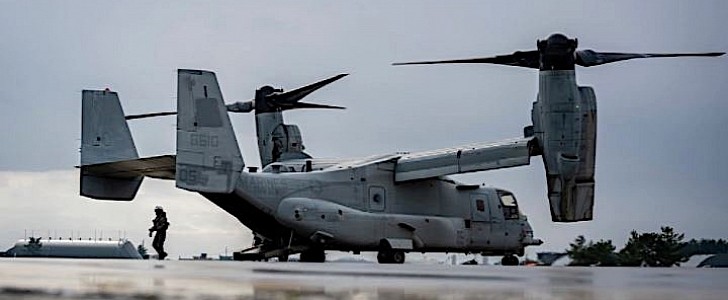It’s been a very exciting year for the U.S. Marines deployed in the Pacific, for a number of reasons. One of them, and of particular interest to us today, is the fact they got to play around, a lot, with MV-22 Ospreys.
The machine, built by Bell and Boeing ever since the 1980s, is only now beginning to understand its full capabilities, thanks to the various trials and tribulations it is subjected to at the hands of the Marines.
Back April, for instance, we learned of an undisclosed number of Ospreys entering the history books of 1st Marine Aircraft Wing after they flew, thanks to Marine Medium Tiltrotor Squadron 363 (VMM-363), for a total of 4,730 nautical miles (5,443 miles/8,760 km). It was a flight from from Hawaii to the Philippines, for a military exercise, and it happened during a self-deploy mission - for the entire flight, the mission included just a single aerial refueling operation.
That distance was dwarfed earlier in September, a feat that was just announced, by Marine Medium Tiltrotor Squadron 268 (VMM-268), part of the same Wing. On September 13, two MV-22 Ospreys departed Darwin, accompanied by a KC-130J aerial tanker, in a long-range maritime self-deployment mission.
This trip included stops in Fiji, American Samoa, and the Republic of Kiribati, but still remains impressive in scope, as it concluded some 6,100 miles (9,800 km) from where it departed, halfway across the Pacific, at Marine Corps Base Hawaii Kaneohe Bay.
The route chosen somewhat mimicked the path the Marines had to take during the so-called island-hopping campaign of World War II, with each stop being “historically significant in the South Pacific and steeped in Marine Corps lore.”
All these places were expeditionary staging bases for American forces during the Pacific war, and the route tested this September will probably become a more routine patrolling one for forces in the area, according to the USMC.
Back April, for instance, we learned of an undisclosed number of Ospreys entering the history books of 1st Marine Aircraft Wing after they flew, thanks to Marine Medium Tiltrotor Squadron 363 (VMM-363), for a total of 4,730 nautical miles (5,443 miles/8,760 km). It was a flight from from Hawaii to the Philippines, for a military exercise, and it happened during a self-deploy mission - for the entire flight, the mission included just a single aerial refueling operation.
That distance was dwarfed earlier in September, a feat that was just announced, by Marine Medium Tiltrotor Squadron 268 (VMM-268), part of the same Wing. On September 13, two MV-22 Ospreys departed Darwin, accompanied by a KC-130J aerial tanker, in a long-range maritime self-deployment mission.
This trip included stops in Fiji, American Samoa, and the Republic of Kiribati, but still remains impressive in scope, as it concluded some 6,100 miles (9,800 km) from where it departed, halfway across the Pacific, at Marine Corps Base Hawaii Kaneohe Bay.
The route chosen somewhat mimicked the path the Marines had to take during the so-called island-hopping campaign of World War II, with each stop being “historically significant in the South Pacific and steeped in Marine Corps lore.”
All these places were expeditionary staging bases for American forces during the Pacific war, and the route tested this September will probably become a more routine patrolling one for forces in the area, according to the USMC.










